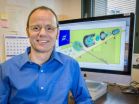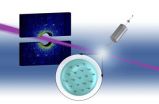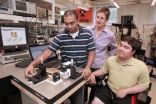(Press-News.org) Scientists have, for the first time, characterized so-called quantum vortices that swirl within tiny droplets of liquid helium. The research, led by scientists at the U.S. Department of Energy's Lawrence Berkeley National Laboratory (Berkeley Lab), the University of Southern California, and SLAC National Accelerator Laboratory, confirms that helium nanodroplets are in fact the smallest possible superfluidic objects and opens new avenues to study quantum rotation.
"The observation of quantum vortices is one of the most clear and unique demonstrations of the quantum properties of these microscopic objects," says Oliver Gessner, senior scientist in the Chemical Sciences Division at Berkeley Lab. Gessner and colleagues, Andrey Vilesov of the University of Southern California and Christoph Bostedt of SLAC National Accelerator Laboratory at Stanford, led the multi-facility and multi-university team that published the work this week in Science.
The finding could have implications for other liquid or gas systems that contain vortices, says USC's Vilesov. "The quest for quantum vortices in superfluid droplets has stretched for decades," he says. "But this is the first time they have been seen in superfluid droplets."
Superfluid helium has long captured scientist's imagination since its discovery in the 1930s. Unlike normal fluids, superfluids have no viscosity, a feature that leads to strange and sometimes unexpected properties such as crawling up the walls of containers or dripping through barriers that contained the liquid before it transitioned to a superfluid.
Helium superfluidity can be achieved when helium is cooled to near absolute zero (zero kelvin or about -460 degrees F). At this temperature, the atoms within the liquid no longer vibrate with heat energy and instead settle into a calm state in which all atoms act together in unison, as if they were a single particle.
For decades, researchers have known that when superfluid helium is rotated--in a little spinning bucket, say--the rotation produces quantum vortices, swirls that are regularly spaced throughout the liquid. But the question remained whether anyone could see this behavior in an isolated, nanoscale droplet. If the swirls were there, it would confirm that helium nanodroplets, which can range in size from tens of nanometers to microns, are indeed superfluid throughout and that the motion of the entire liquid drop is that of a single quantum object rather than a mixture of independent particles.
But measuring liquid flow in helium nanodroplets has proven to be a serious challenge. "The way these droplets are made is by passing helium through a tiny nozzle that is cryogenically cooled down to below 10 Kelvin," says Gessner. "Then, the nanoscale droplets shoot through a vacuum chamber at almost 200 meters-per-second. They live once for a few milliseconds while traversing the experimental chamber and then they're gone. How do you show that these objects, which are all different from one another, have quantum vortices inside?"
The researchers turned to a facility at SLAC called the Linac Coherent Light Source (LCLS), a DOE Office of Science user facility that is the world's first x-ray free-electron laser. This laser produces very short light pulses, lasting just a ten-trillionth of a second, which contain a huge number of high-energy photons. These intense x-ray pulses can effectively take snapshots of single, ultra-fast, ultra-small objects and phenomena.
"With the new x-ray free electron laser, we can now image phenomenon and look at processes far beyond what we could imagine just a decade ago," says Bostedt of SLAC. "Looking at the droplets gave us a beautiful glimpse into the quantum world. It really opens the door to fascinating sciences."
In the experiment, the researchers blasted a stream of helium nanodroplets across the x-ray laser beam inside a vacuum chamber; a detector caught the pattern that formed when the x-ray light diffracted off the drops.
The diffraction patterns immediately revealed that the shape of many droplets were not spheres, as was previously assumed. Instead, they were oblate. Just as the Earth's rotation causes it to bulge at the equator, so too do rotating nanodroplets expand around the middle and flatten at the top and bottom.
But the vortices themselves are invisible to x-ray diffraction, so the researchers used a trick of adding xenon atoms to the droplets. The xenon atoms get pulled into the vortices and cluster together.
"It's similar to pulling the plug in a bathtub and watching the kids' toys gather in the vortex," says Gessner. The xenon atoms diffract x-ray light much stronger than the surrounding helium, making the regular arrays of vortices inside the droplet visible. In this way, the researchers confirmed that vortices in nanodroplets behave as those found in larger amounts of rotating superfluid helium.
Armed with this new information, the researchers were able to determine the rotational speed of the nanodroplets. They were surprised to find that the nanodroplets spin up to 100,000 times faster than any other superfluid helium sample ever studied in a laboratory.
Moreover, while normal liquid drops will change shape as they spin faster and faster--to resemble a peanut or multi-lobed globule, for instance--the researchers saw no evidence of such shapeshifting in the helium nanodroplets. "Essentially, we're exploring a new regime of quantum rotation with this matter," Gessner says.
"It's a new kind of matter in a sense because it is a self-contained isolated superfluid," he adds. "It's just all by itself, held together by its own surface tension. It's pretty perfect to study these systems if one wants to understand superfluidity and isolate it as much as possible."
INFORMATION:
This research was supported by the DOE Office of Science, Office of Basic Energy Sciences, Chemical Sciences, Geosciences and Biosciences Division as well as the National Science Foundation.
Lawrence Berkeley National Laboratory addresses the world's most urgent scientific challenges by advancing sustainable energy, protecting human health, creating new materials, and revealing the origin and fate of the universe. Founded in 1931, Berkeley Lab's scientific expertise has been recognized with 13 Nobel prizes. The University of California manages Berkeley Lab for the U.S. Department of Energy's Office of Science. For more, visit http://www.lbl.gov.
The DOE Office of Science is the single largest supporter of basic research in the physical sciences in the United States and is working to address some of the most pressing challenges of our time. For more information, please visit science.energy.gov.
Researchers map quantum vortices inside superfluid helium nanodroplets
First ever snapshots of spinning nanodroplets reveal surprising features
2014-08-21
ELSE PRESS RELEASES FROM THIS DATE:
Sunlight, not microbes, key to CO2 in Arctic
2014-08-21
CORVALLIS, Ore. – The vast reservoir of carbon stored in Arctic permafrost is gradually being converted to carbon dioxide (CO2) after entering the freshwater system in a process thought to be controlled largely by microbial activity.
However, a new study – funded by the National Science Foundation and published this week in the journal Science – concludes that sunlight and not bacteria is the key to triggering the production of CO2 from material released by Arctic soils.
The finding is particularly important, scientists say, because climate change could affect when ...
A novel 'man and machine' decision support system makes malaria diagnostics more effective
2014-08-21
A Finnish-Swedish research group at the Institute for Molecular Medicine Finland (FIMM), University of Helsinki, and Karolinska institutet, Stockholm, has developed a novel "man and machine" decision support system for diagnosing malaria infection. This innovative diagnostic aid was described in PLOS One scientific journal today, 21 August. The method is based on computer vision algorithms similar to those used in facial recognition systems combined with visualization of only the diagnostically most relevant areas. Tablet computers can be utilized in viewing the images.
In ...
Scientists observe quantum vortices in cold helium droplets
2014-08-21
An international research team including DESY scientists has observed tiny quantum vortices in cold droplets of liquid helium. The team reports in the journal Science that the exotic vortices arrange themselves as densely packed lattices inside the nanodroplets. It is the first time that the quantum vortices, which have already been observed in larger samples of what is known as superfluid helium, have been detected in nanodroplets. "The experiment has exceeded our best expectations," says Andrey Vilesov of the University of Southern California, one of the experiment's ...
Hot-spring bacteria reveal ability to use far-red light for photosynthesis
2014-08-21
Bacteria growing in near darkness use a previously unknown process for harvesting energy and producing oxygen from sunlight, a research team led by a Penn State University scientist has discovered. The discovery lays the foundation for further research aimed at improving plant growth, harvesting energy from the Sun, and understanding dense blooms like those now occurring on Lake Erie and other lakes worldwide. A paper describing the discovery will be published in the Science Express edition of the journal Science on 21 August 2014.
"We have shown that some cyanobacteria, ...
New DNA test for diagnosing diseases linked to childhood blindness
2014-08-21
SAN FRANCISCO – Aug. 21, 2014 – Researchers in the United Kingdom have demonstrated that advanced DNA testing for congenital cataracts can quickly and accurately diagnose a number of rare diseases marked by childhood blindness, according to a study published online today in Ophthalmology, the journal of the American Academy of Ophthalmology. Using a single test, doctors were able to tailor care specifically to a child's condition based on their mutations reducing the time and money spent on diagnosis and enabling earlier treatment and genetic counseling.
Each year, ...
USC Eye Institute study shows Native American ancestry a risk factor for eye disease
2014-08-21
LOS ANGELES — New research led by the University of Southern California (USC) Eye Institute, part of Keck Medicine of USC, shows for the first time that Native American ancestry is a significant risk factor for vision-threatening diabetic retinopathy among Latinos with Type 2 diabetes. Diabetic retinopathy is the leading cause of blindness in working-age adults in the United States, affecting more than 4 million Americans age 40 and older.
The research was published online today in Investigative Ophthalmology & Visual Science, the peer-reviewed academic journal of The ...
Novel recycling methods: The fluorescent fingerprint of plastics
2014-08-21
Researchers at Ludwig-Maximilians-Universitaet (LMU) in Munich have developed a new process which will greatly simplify the process of sorting plastics in recycling plants. The method enables automated identification of polymers, facilitating rapid separation of plastics for re-use.
A team of researchers led by Professor Heinz Langhals of LMU's Department of Chemistry has taken a significant step which promises to markedly expedite the recycling of plastic waste. They have developed a technique which provides for automated recognition of their polymer constituents, thus ...
CHEST releases new expert guidance in care of the critically ill and injured
2014-08-21
The American College of Chest Physicians (CHEST) announces the immediate release of Care of the Critically Ill and Injured During Pandemics and Disasters: CHEST Consensus Statement today in the Online First section of the journal CHEST while the global health-care community cares for patients with the Ebola virus. The consensus statement aims to guide ethical decision-making, coordination of care, resource conservation, and research in crises. The statement was developed by over 100 clinicians and experts representing a broad variety and scope of clinical fields from more ...
Laser device may end pin pricks, improve quality of life for diabetics
2014-08-21
Princeton University researchers have developed a way to use a laser to measure people's blood sugar, and, with more work to shrink the laser system to a portable size, the technique could allow diabetics to check their condition without pricking themselves to draw blood.
"We are working hard to turn engineering solutions into useful tools for people to use in their daily lives," said Claire Gmachl, the Eugene Higgins Professor of Electrical Engineering and the project's senior researcher. "With this work we hope to improve the lives of many diabetes sufferers who depend ...
Objectification in romantic relationships related to sexual pressure and coercion
2014-08-21
To sexually objectify a woman is to focus on her body in terms of how it can provide sexual pleasure rather than viewing her as a complete human being with thoughts and feelings. While objectification has long been considered a problem in the media, how does it affect individual romantic relationships? New research published in Psychology of Women Quarterly, a SAGE journal, finds that more objectification of a female partner's body is related to higher incidents of sexual pressure and coercion.
Researchers Laura R. Ramsey and Tiffany Hoyt surveyed 119 males and 162 females ...
LAST 30 PRESS RELEASES:
University of Oklahoma researcher awarded funding to pursue AI-powered material design
Exploring how the visual system recovers following injury
Support for parents with infants at pediatric check-ups leads to better reading and math skills in elementary school
Kids’ behavioral health is a growing share of family health costs
Day & night: Cancer disrupts the brain’s natural rhythm
COVID-19 vaccination significantly reduces risk to pregnant women and baby
The role of vaccination in maternal and perinatal outcomes associated with COVID-19 in pregnancy
Mayo Clinic smartwatch system helps parents shorten and defuse children's severe tantrums early
Behavioral health spending spikes to 40% of all children’s health expenditures, nearly doubling in a decade
Digital cognitive behavioral treatment for generalized anxiety disorder
Expenditures for pediatric behavioral health care over time and estimated family financial burden
Air conditioning in nursing homes and mortality during extreme heat
The Alps to lose a record number of glaciers in the next decade
What makes a good proton conductor?
New science reporting guide published for journalists in Bulgaria
New international study reveals major survival gaps among children with cancer
New science reporting guide published for journalists in Turkey
Scientists develop a smarter mRNA therapy that knows which cells to target
Neuroanatomy-informed brain–machine hybrid intelligence for robust acoustic target detection
Eight SwRI hydrogen projects funded by ENERGYWERX
The Lundquist Institute and its start-up company Vitalex Biosciences Announces Strategic Advancement of Second-Generation fungal Vaccine VXV-01 through Phase 1 Trials under $40 Million Competitive Con
Fine particles in pollution are associated with early signs of autoimmune disease
Review article | Towards a Global Ground-Based Earth Observatory (GGBEO): Leveraging existing systems and networks
Penn and UMich create world’s smallest programmable, autonomous robots
Cleveland researchers launch first major study to address ‘hidden performance killer’ in athletes
To connect across politics, try saying what you oppose
Modulating key interaction prevents virus from entering cells
Project explores barriers to NHS career progression facing international medical graduates
Jeonbuk National University researchers explore the impact of different seasonings on the flavor perception of Doenjang soup
Two Keck Medicine of USC Hospitals named Leapfrog Top Teaching Hospitals
[Press-News.org] Researchers map quantum vortices inside superfluid helium nanodropletsFirst ever snapshots of spinning nanodroplets reveal surprising features





